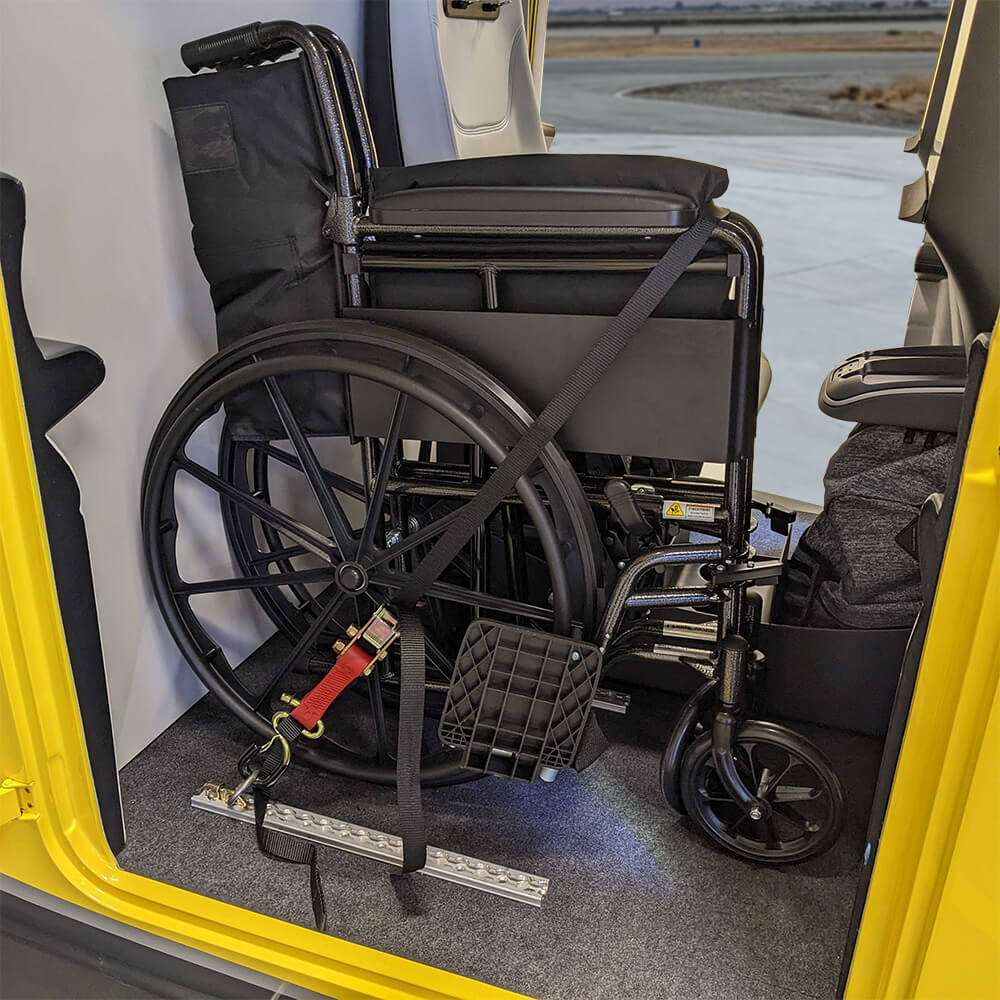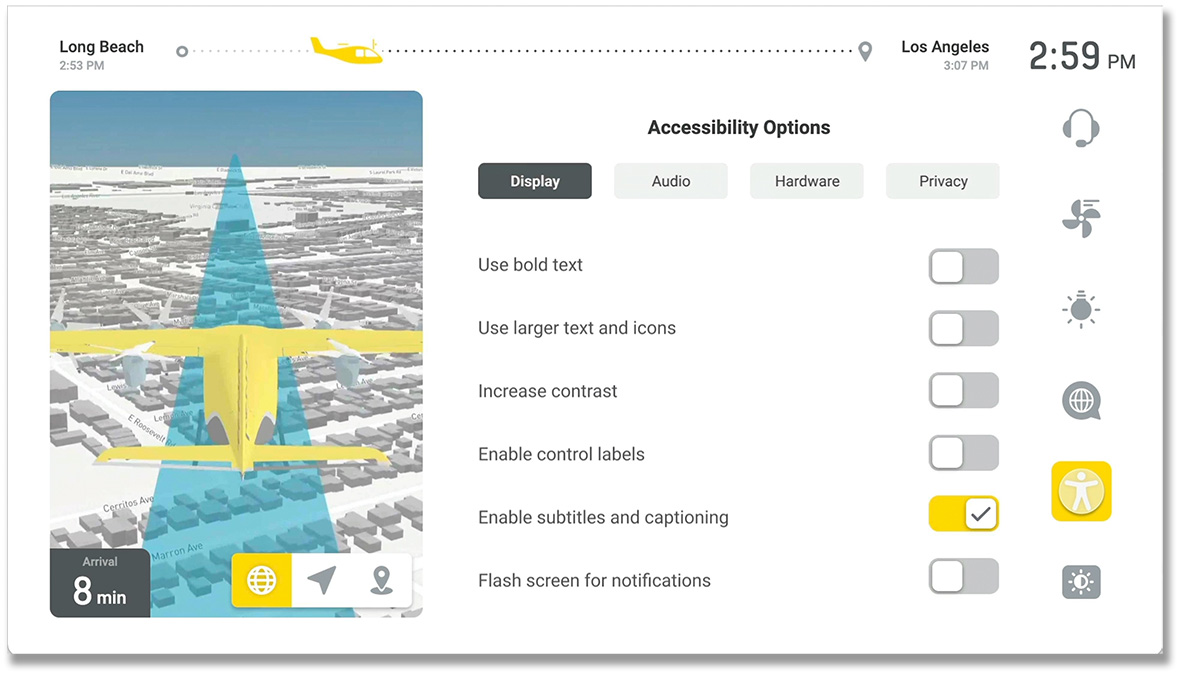A Changing Perspective
“The current bar for accessibility standards in aviation is too low,” says Saurabh Nimsarkar, one of our Senior User Interface/User Experience (UI/UX) Designers, “we want to surpass industry standards and do better. We are working to make accessibility a part of our brand ethos.”
Nimsarkar is a member of our Product Design Team, which has tasked itself with redefining the passenger experience to empower people living with disabilities. This is no small task. Contemporary eVTOLs have been described as ‘compact-verging-on-cramped’ as designers across the industry attempt to balance weight and power limitations with functionality, comfort, and regulatory requirements.
With these limitations in mind “we have decided to focus on inclusivity and make accessibility a driving force behind our design,” says Wisk’s Director of Product Design, Uri Tzarnotzky. Following universal design principles, the team has started the complex journey of ensuring that all passengers can enjoy their trip in comfort and with dignity. Universal design, according to the National Disability Authority, “is the design and composition of an environment so that it can be accessed, understood, and used to the greatest extent possible by all people regardless of their age, size, ability or disability.”
Because the eVTOL and Advanced Air Mobility (AAM) industry is still emerging, now is the time to raise the bar on accessibility. In an interview with Vertical Magazine, UX Specialist Paula Macedo highlighted that the ‘narrative’ that develops in the eVTOL industry “will influence directly how the ecosystem will include or exclude someone.” Wisk is aiming to be as inclusive as possible, “we want to change perception and stigma around disability in aviation and set a societal benchmark,” said Tzarnotzky, “and to do that we intend to seek continuous feedback from a wide range of stakeholders.”
Current Accessibility Efforts
Part of changing the narrative means getting better insight into the experience of travelers with disabilities. Nimsarkar notes that “there remains a significant research gap in understanding the needs of people with disabilities.” This is a gap that Wisk seeks to narrow. Wisk has already conducted three consumer research studies that included children, the elderly, and people who rely on assistive mobility devices such as canes, walkers, and wheelchairs. This research was then used to inform design decisions, both big and small, in our recently released Generation 6 aircraft.

The Generation 6 aircraft embraces universal design principles, foremost by recognizing that passengers are not one-size-fits-all. The cabin has been designed to provide comfortable seating, reachability, and field of view for the 5th percentile female up to the 95 percentile male. For customers with mobility limitations and assistive mobility devices the lower door sills were eliminated, grips were thoughtfully placed for easy ingress, and seats were made removable to provide additional space.
Digital Interfaces
Sr. UI/UX Designer Scott Rossi is leading the user interface aspect of Wisk’s accessibility efforts. User interfaces include the touchscreens in the aircraft itself, as well as any future integration with travel apps where passengers can book their flights and indicate their travel and communication preferences. “We did research on disabilities overall as a topic area and identified four major categories of accessibility that we wanted to address: vision, hearing, mobility, and cognitive.”

Rossi notes that “Communication is key to traveling in comfort, and this includes inflight instruction as well as providing a clear understanding of what the pre- and post-flight experience will be.” Based on this information, the Product Design team has started working on a user interface with multiple modes of communication, such as auditory announcements, closed captioning, and standard ASL interpretation. The color scheme is amenable to the most common forms of color blindness. Additional affordances include a screen reader and the ability to bold text, increase text size, and increase screen contrast.
In the future, the hope is that Wisk passengers will be able to create a personalized profile that will empower them throughout their journey and on all future flights, making travel with Wisk easy, comfortable, and memorable.
The Need for More Research and Engagement
Wisk has begun working with the American Association of People with Disabilities to help ensure ADA and ACAA compliance. However, we recognize that there is more to be done in research and implementation.
Future accessibility-specific studies are planned to start early next year. Forthcoming studies aim to understand the entire traveling process for individuals living with disabilities, from what drives the desire to travel through to how passengers feel about the journey afterward. Our goal is to develop a relationship with participants where we can systematically and respectfully identify travel pain points for passengers living with disabilities. Our research teams will then be able to provide actionable recommendations for services and features to resolve or mitigate barriers to traveling with Wisk. The hope is to develop long-term partnerships with people living with disabilities that can continuously inform our development long after the research clinics have concluded.
As NASA researcher Larry Young emphasized, the value of urban air mobility is its ability to save time. Not just time saved while the aircraft is in flight, but the time saved during the overall journey, from ‘door-to-door’. In other words, “it is important to consider not only accessibility from the perspective of just the vehicle but the overall system-of-systems network inherent in the UAM concept.”
As research is conducted, Wisk is committed to a continuous process of feedback and improvement, the ultimate goal of which is to develop insights and design principles that can inform future development and ensure that individuals with disabilities feel comfortable and welcomed aboard our aircraft.